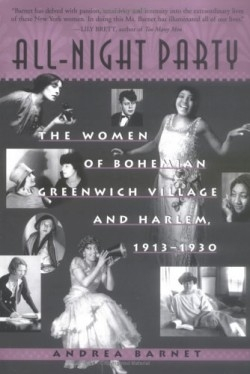All-Night Party
The Women of Bohemian Greenwich Village and Harlem 1913-1930
The mere mention of New York in the twenties automatically conjures up a host of wild and vivid images: flapper-provocateurs, freshly minted millionaires, and witty raconteurs hopping from seedy speakeasy to lavish party to steamy jazz club, night after night, and well into most mornings. But bohemian life in New York between the World Wars was far more subversive and had a much greater social impact than the popular notions of decadent play that loom so large now in our collective imagination.
In her first book, the author, a magazine journalist who has contributed to the New York Times Book Review, the Smithsonian Magazine, and Harper’s Bazaar, surveys the cultural landscape of the Jazz Age, paying close attention to the social roots that fed the rebellious, decadent spirit of a time and place brought so irresistibly, indelibly to life by F. Scott Fitzgerald.
The eight women whom Barnet profiles in depth—poet and conceptual artist Mina Loy, avant-garde editor/publisher Margaret Anderson and her partner Jane Heap, free-spirited poet Edna St. Vincent Millay, wealthy hostesses Mabel Dodge and A’Lelia Walker, defiant blues singer Bessie Smith, and pop-jazz pioneer Ethel Waters—were some of the more revolutionary and fearless early proponents of feminism and modernity. Barnet clearly delights in recounting their outrageous antics, and liberally applies colorful detail throughout.
When told by a notoriously bigoted Atlanta theater owner that she couldn’t enter his building through the front door, Bessie Smith marched in anyway, but not before informing him: “I don’t give a fuck, and if you don’t like it, kiss my black ass.” Margaret Anderson moved her entourage to live in tents on the beach one summer because she couldn’t afford to pay rent and continue publishing her literary journal. That journal later became the first publisher of James Joyce’s Ulysses, serializing it for more than three years. A’Lelia Walker, the richest black woman in America, constantly entertained in her palatial Renaissance-style mansion on the Hudson. It was here that the denizens of Bohemian Greenwich Village and the creative forces fueling the Harlem Renaissance first commingled—along with European royalty, local mobsters, movie stars, and assorted freeloaders and hangers-on.
It’s unfortunate that the book doesn’t present an artistic and intellectual context in which to see the work each of its subjects. That may be too tall an order for a survey across so many disciplines, but Barnet does fully capture the gleefully subversive ethos of life as performance art, and the air of lawless idealism that briefly raised dissent and transgression to an art form.
Reviewed by
Emily Mead
Disclosure: This article is not an endorsement, but a review. The publisher of this book provided free copies of the book to have their book reviewed by a professional reviewer. No fee was paid by the publisher for this review. Foreword Reviews only recommends books that we love. Foreword Magazine, Inc. is disclosing this in accordance with the Federal Trade Commission’s 16 CFR, Part 255.

